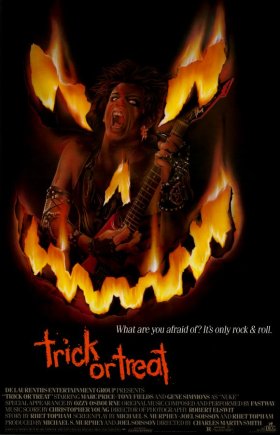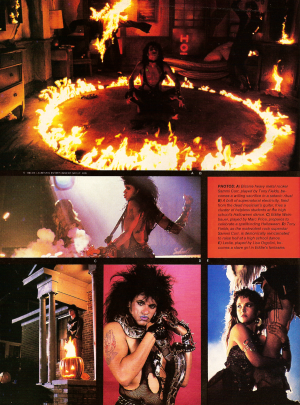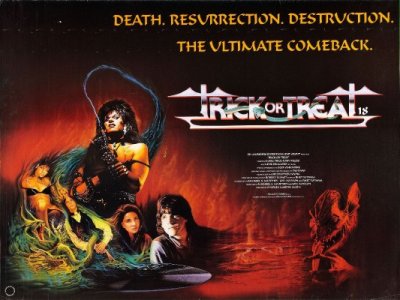Discussing the theme of “backmasked” messages in heavy metal music during the Satanic Panic, as explored in the 1986 comedy horror film, Trick or Treat.

One of my all-time favorite movies is a flick that hardly anyone seems to know about. You have to be a real 1980s horror nerd to have seen Charles Martin Smith’s Trick or Treat (1986), and it probably helps if you’re a metalhead too. I’ve never once seen the flick listed on anyone’s “Top 10 Favorite Movies” list, but you will certainly find it on mine, and I’ll tell you why. To the best of my knowledge, this is the first film ever made that features a plot inspired entirely by heavy metal and the hatred it received from politicians, televangelists, and self-righteous soccer moms during the 1980’s Satanic Panic. It may not necessarily be the best film of its subgenre; undoubtedly, many people would probably vote for Jason Lei Howden’s Deathgasm (2015), which has a very similar plot. But despite Deathgasm’s superior production values, Trick or Treat did it first, and it made a huge impression on me while I was growing up.
Eddie Weinbauer (played by Marc Price, better known as “Skippy” from Family Ties) is a teenage metalhead who lives in the town of Lakeridge, North Carolina, and who goes by the nickname “Ragman.” Eddie is especially dedicated to the music of Sammi Curr (Tony Fields), a glam metal shock rocker who’s obviously inspired by Alice Cooper. Eddie absolutely worships Sammi, and he’s friends with a radio DJ named “Nuke” (Gene Simmons of KISS), a nerd named Roger (Glen Morgan, one of the lead writers for The X-Files and the Final Destination movies), and a pretty girl at his school named Leslie (Lisa Orgolini). Unfortunately, Ragman is also bullied at his school by a bunch of jocks (led by Doug Savant of Desperate Housewives fame), who all think he’s creepy and weird. These guys are pretty harsh, too, because they apparently see nothing wrong with trying to drown poor Eddie in a swimming pool.

Why does Ragman dig Sammi Curr so much? Because Curr’s music helps him cope with his feelings of subjugation. In a strange way, Curr is eerily prophetic of Marilyn Manson, who took shock rock to a whole new level in the 1990s. Not content with just scaring or pissing off parents, Manson made himself into a full-blown culture war iconoclast (the “Antichrist Superstar”) and deliberately terrorized the entire American Religious Right. In a similar way, Curr uses his music and his fanbase to declare war on society. He offers his fans a future in which “Rock’s Chosen Warriors will rule the Apocalypse,” and he promises all who try to ban his music that “We will bring you down.” For Eddie, Curr is more than just a rock icon or a hero; he’s a counter-cultural messiah who promises total emancipation from Christian society.
But all of this seems to vanish into thin air when Eddie turns on the TV one morning to learn that Sammi Curr has died in a hotel fire. The boy is instantly crushed and descends into despair, but when he visits his friend Nuke at the local WZLP radio station, Nuke gives him a special gift. You see, Sammi Curr actually grew up right here in Eddie’s hometown, and Nuke was friends with him when they were kids. As it turns out, Nuke just happens to have a demo recording of an album Curr was still recording when he died. (The album is named Songs in the Key of Death.) Nuke gives the record to Eddie, telling him Sammi would have wanted him to have it. And while listening to it later that night, Eddie discovers the album contains a bunch of backmasked messages. Then he plays the record in reverse to see what the messages are saying, and that’s when he receives the biggest shock of his life.

Eddie “Ragman” Weinbauer and his hero, Sammi Curr.
The voice of Sammi Curr speaks to Eddie through the backmasked messages, telling the boy to do certain things while he’s at school the next day. When Eddie follows the advice he is given, he outsmarts his foes and gets them in trouble (while getting away scotch free, himself). It then seems like the two conspirators will get to realize their shared vision of a world without bullies after all; but as Curr continues to help Ragman “nail” his tormenters, he also demands the boy’s help in “nailing” everyone who ever tried to ban his music. Their Halloween pranks soon turn deadly, and Ragman realizes his beloved demigod is actually a demon. By the end, Eddie must stop Sammi from killing everyone in Lakeridge when Nuke plays Songs in the Key of Death backwards on his radio show (on All Hallows’ Eve, no less).
Now I know good and well what some of you must be thinking. Trick or Treat sounds like something that was made by evangelical Christians, right? It sounds like the entire point of the film is to demonize heavy metal and anyone who listens to it. As a devoted metalhead myself, I probably shouldn’t enjoy this film at all, should I? But consider the fact that Ozzy Osbourne appears in a cameo as “the Reverend Aaron Gilstrom,” an anti-rock televangelist. Yes, you read that correctly: Ozzy fuckin’ Osbourne plays a Jimmy Swaggart clone who preaches that metal musicians are all Satanists brainwashing our kids. (Now that’s what I call irony!) I might also point out that Trick or Treat doesn’t quite end the way you’d expect. If this were an evangelical propaganda film like Rock: It’s Your Decision (1982), Eddie would swear off metal for good after defeating Sammi Curr and “give himself to Jesus” (as they say). But after he defeats the ghost of the man who used to be his hero, what do you suppose Ragman actually does?
By Gods, he plays a Gods-damn Sammi Curr record!
Yes, that’s right—and I think this is where Trick or Treat really shines the most. While the film is inspired by urban American myths about “backmasking” in heavy metal music, it obviously does not agree with the people who take such fears literally. Instead, the film presents metal as something that’s legitimately fun but misunderstood—and not only by parents, preachers, or politicians. Eddie Weinbauer eventually sees that Sammi Curr is a much worse bully than any of the jocks who’ve been tormenting him at Lakeridge High. But when Eddie takes Sammi down, he isn’t turning his back on metal (or even on Curr’s music, necessarily). He’s just learning to separate the art he loves from the artist who created it. The artist might be a major asshole, but it’s OK to still enjoy and take inspiration from their art.
When I was in high school, I used to worship the ground Marilyn Manson walked on. But then I learned he really isn’t the all-powerful “Antichrist Superstar” he made himself out to be. At first, this made me feel like I could never listen to Manson’s music again; my sense of disappointment was just too much. But after a while, I learned that art can still be deeply meaningful and magical even if the person who created it is not who (or what) I want them to be. I went through this exact same process with Alice Cooper and Ozzy Osbourne. In heavy metal especially, it’s easy to confuse the people creating the music with the characters they play on stage. Marilyn, Alice, and Ozzy aren’t real people; they’re bigger-than-life personas that were created by Brian Warner, Vincent Furnier, and John Osbourne, respectively. The funny thing is that once I finally began to understand this principle, I started to enjoy their music even more.

Some promotional photos for the film.
In Trick or Treat, the problem is not with heavy metal itself, but with the fact that Sammi Curr takes his hype and his stage persona way too seriously. When Eddie fights him, Sammi accuses him of being “false metal”—but in reality, Sammi is the one who is false. Part of the fun to heavy metal is that it’s basically a huge power fantasy that can be taken to some truly ridiculous extremes. What’s more, this is usually done while keeping one’s tongue planted firmly in-cheek. Sure, there are people like Sammi Curr who take themselves way too seriously; but this genre was built on the backs of guys like Coop and Ozzy, who sing about strangling people or having sex with the devil while winking at their audiences. It’s all make-believe, much like a Halloween party that never ends, and the people who take it too seriously—including both the Pat Robertsons and the Varg Vikerneses of this world—are completely missing the point.
Most people who’ve seen Trick or Treat will tell you it’s a total dud. To be fair, it is full of bloopers; you can even see the boom mike at the top of the screen at one point. (Keep your eyes peeled when Ragman answers the front door, only to find his mom’s boyfriend dressed up as Rambo on the other side. Pay close attention to the top right-hand corner of the screen!) The movie also can’t seem to settle on whether it wants to be a genuine horror film or a comedy with horrific overtones, which is something that normally tends to annoy me. But even with all that being said, Trick or Treat is very well-acted, the music is phenomenal (featuring songs by Fastway and a score by Christopher Young), and a great deal of creative effort was clearly put into it. They weren’t just trying to make a quick buck with this one; they were actually trying to make something witty and intelligent—and for my money, at least, they succeeded.
Trick or Treat is also a film that we hold sacred in the LV-426 Tradition (much like 1979’s Alien and 1982’s The Thing). It nicely reflects our own personal histories with Set. We were all like Eddie Weinbauer when we were kids; we were alienated youth, and we coped with our problems by listening to angry, aggressive-sounding music. That same music became one of our various “doorways” into Setianism, and for this reason, we treated our rock heroes like they were pillars of wisdom and virtue. Big Red had to disabuse us of this notion over time; like Ragman, we had to learn how to enjoy our favorite artists without believing in all their hype, and Trick or Treat reminds us of what it was like to go through all of that.

Alternate poster art for the film.
